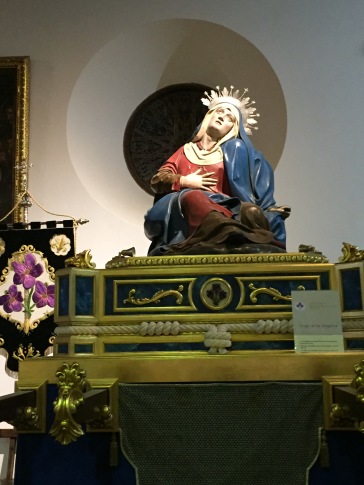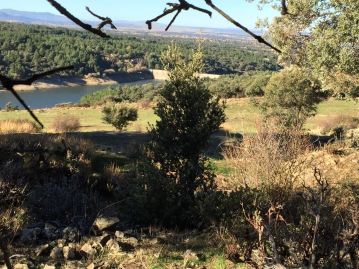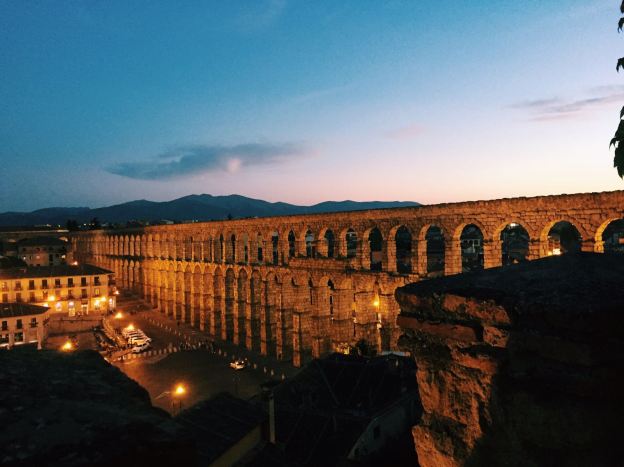Como ya dije, tenía que volver a ver el Corpus Christi, que tanto llamó mi atención al hacer el paseo de la ciudad. La iglesia del Corpus Christi está en la calle real, casi en el último cruce antes de llegar a Plaza Mayor. Está ahí también el Convento de Santa Clara de Asís donde vive la fraternidad de las hermanas Clarisas.
 Al entrar se baja y gira a la derecha. A la izquierda están las hermanas Clarisas vendiendo sus maravillosos postres y más abajo se puede entrar a la Iglesia de Corpus Christi. La Iglesia es pequeña pero muy acogedora. Tiene ya un nacimiento enorme y lindísimo para la Navidad. Sus decoraciones, vitrales y obras como el retablo de la Concesión del Jubileo de la Porciúncula son espectaculares. La Iglesia fue una Sinagoga desde su construcción hasta que en 1410, los judios fueron acusados de un intento de profanación, lo que llevó a la confiscación de la misma por parte de Catalina de Lancaster. Desgraciadamente en 1899 hubo un incendio que destruyó gran parte del edificio, viéndose obligados a desalojarlo, hasta su rehabilitación en 1902. En el año 2004 hubo otra rehabilitación que ha supuesto que, a día de hoy, cueste creer que hubo alguna vez un incendio así ahí. En Ecuador hay una Iglesia en la parte antigua de Quito que se llama La Compañía que tuvo un incendio similar, pero pese a varias rehabilitaciones e intentos de mejora aún se puede ver que alguna vez hubo un incendio tan fuerte.
Al entrar se baja y gira a la derecha. A la izquierda están las hermanas Clarisas vendiendo sus maravillosos postres y más abajo se puede entrar a la Iglesia de Corpus Christi. La Iglesia es pequeña pero muy acogedora. Tiene ya un nacimiento enorme y lindísimo para la Navidad. Sus decoraciones, vitrales y obras como el retablo de la Concesión del Jubileo de la Porciúncula son espectaculares. La Iglesia fue una Sinagoga desde su construcción hasta que en 1410, los judios fueron acusados de un intento de profanación, lo que llevó a la confiscación de la misma por parte de Catalina de Lancaster. Desgraciadamente en 1899 hubo un incendio que destruyó gran parte del edificio, viéndose obligados a desalojarlo, hasta su rehabilitación en 1902. En el año 2004 hubo otra rehabilitación que ha supuesto que, a día de hoy, cueste creer que hubo alguna vez un incendio así ahí. En Ecuador hay una Iglesia en la parte antigua de Quito que se llama La Compañía que tuvo un incendio similar, pero pese a varias rehabilitaciones e intentos de mejora aún se puede ver que alguna vez hubo un incendio tan fuerte.

A la salida me pasé a ver lo que había en el Convento. Las hermanas Clarisas venden maravillosos dulces que hacen entre comunidades de hermanas que se ayudan entre sí. Todos se ven buenísimos como pueden ver. Pásense a descubrir ésta maravilla que esconde Segovia.
As I said I had to go back to see the Corpus Christi that called my attention so much when I did the city tour. The Church of Corpus Christi is located in the Calle Real very near Plaza Mayor. The Convent of Santa Clara de Asís where the sisterhood of the Clarisa’s sisters live is right next to the church.
When you go in, you go down a small street and turn right, to the left you’ll find the sisters selling their amazing pastries and a bit further down you can find the Corpus Christi church. The Church is small but very cozy. It already has a big beautiful manger inside for Christmas. It has even more beautiful decorations, vitrals and works like the retraining of the Concession of the Jubilee de la Porciúncula. The Church was previously a Synagogue from its construction until 1410. Unfortunatedly, in 1899 there was a massive fire that destroyed a big part of the building and forced the sisters to have to evict the premises until its restructuring in 1902. There was another restructuration in 2004 that must have left what now is a place where a fire of that magnitude is hard to believe ever happened.
 As I left I passed by the Convent to see what they had. The Clarisa sisters sell amazing sweets that they make together and sell to help each other as sister’s communities. They all look amazing as you can see. Go discover this wonder Segovia was hiding in its streets!
As I left I passed by the Convent to see what they had. The Clarisa sisters sell amazing sweets that they make together and sell to help each other as sister’s communities. They all look amazing as you can see. Go discover this wonder Segovia was hiding in its streets!











 Una vez en la Plaza Mayor pudimos visitar la Catedral por dentro y fue realmente bellísima. ¡Hasta hice una amiga ahí del tour! Más adelante seguimos por las calles antiguas hasta llegar al Alcázar donde también pudimos entrar. Allí ya había entrado, pero siempre es una experiencia encantadora poder entrar al castillo de la Cenicienta y disfrutar las vistas que hay desde allí. En el mismo Alcázar es donde termina el tour, dejando tiempo para disfrutar de las vistas de las montañas y del resto de atractivos rincones del castillo. Les invito a llevar a quienes les visiten o a hacerlo ustedes mismos, ¡vale la pena!
Una vez en la Plaza Mayor pudimos visitar la Catedral por dentro y fue realmente bellísima. ¡Hasta hice una amiga ahí del tour! Más adelante seguimos por las calles antiguas hasta llegar al Alcázar donde también pudimos entrar. Allí ya había entrado, pero siempre es una experiencia encantadora poder entrar al castillo de la Cenicienta y disfrutar las vistas que hay desde allí. En el mismo Alcázar es donde termina el tour, dejando tiempo para disfrutar de las vistas de las montañas y del resto de atractivos rincones del castillo. Les invito a llevar a quienes les visiten o a hacerlo ustedes mismos, ¡vale la pena!







 kilometers away from the city and the views you see from it are out of this world. It has become a point of reference for me whenever I need to calculate distances or to know how to get home, the place where I meet my friends at and most importantly the sight that always fills me when I’m back from any trip, its what gives me the confirmation I’ve finally arrived home.
kilometers away from the city and the views you see from it are out of this world. It has become a point of reference for me whenever I need to calculate distances or to know how to get home, the place where I meet my friends at and most importantly the sight that always fills me when I’m back from any trip, its what gives me the confirmation I’ve finally arrived home.



Comentarios recientes